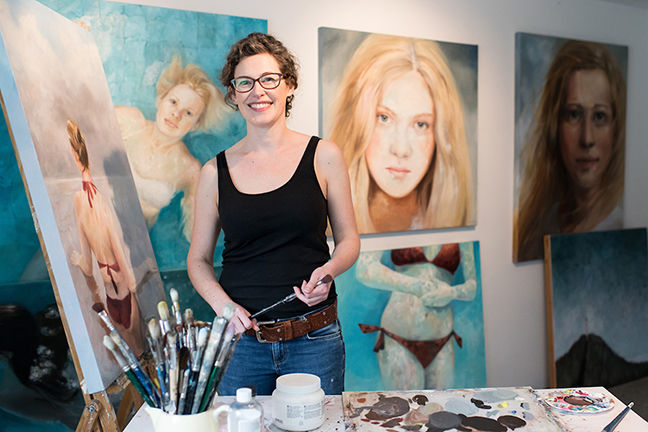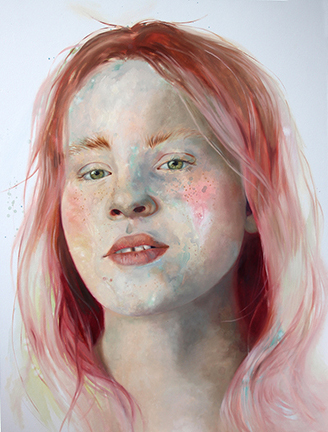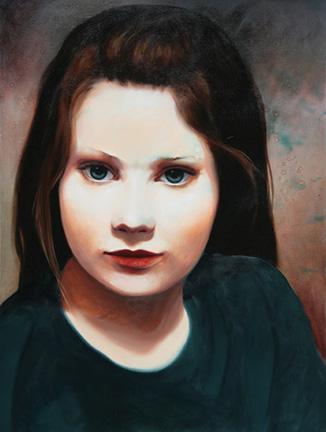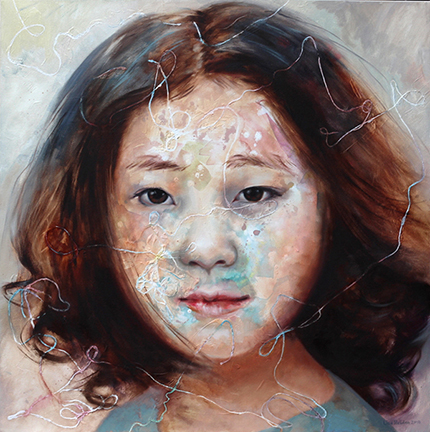Lisa Hebden
Lisa Hebden creates large-scale figurative paintings that capture a sense of lightness and freedom, often ethereal, yet emotional and moving.

Biography
Lisa Hebden was born and raised in Victoria, BC. She attended University of Victoria in the 1990s where she studied creative writing, and went on to earn two degrees (Fine Arts and Graphic Design) at the Nova Scotia College of Art & Design in Halifax in 2002. Lisa travelled extensively and has visited art galleries in many countries, from which she has drawn inspiration in various forms. She has exhibited at group and solo shows in British Columbia, and has received awards including a Painting on the Edge Award from the Federation of Canadian Artists (2003) and two People’s Choice Awards at the Sooke Fine Arts Show (2010 and 2013). Her work has been exhibited at The Gallery at Mattick’s Farm in Victoria, Two Rivers Gallery in Prince George, BC, and Gallery at the Mac in Victoria. Her large figural paintings, many of swimmers and young women, capture a sense of lightness and freedom, often ethereal yet emotional and moving. Examples of her work, contact information, and her blog may be accessed via her web site at:
Selected Excerpts
Audio Quote
“…. what I really wanted to learn was to mix colour.”
Audio Quote
“…. I came across Jenny Saville. And, I just stopped in my tracks. I had never seen anything like it.”
Audio Quote
“There is something magic about conjuring that sort of emotion in someone by something that you’ve made.”
In Conversation with Lisa Hebden
Full Interview
Full Interview Transcription
Edited and transcribed by William Mathews in consultation with Lisa Hebden.
William Mathews (WM): When did you, or why did you decide to become an artist?
Lisa Hebden (LH): Quite honestly it wasn’t a decision, it was just, when I was probably six or seven that was what I wanted to do, I wanted to be an artist, and it was always something that I doubted as an adult, but it was … it sounds so incredibly cliche and cheesy to say it, but it was not a conscious choice.
WM: Right
LH: More of a, this is just what’s gonna be
WM: That’s how it should be
LH: and …. I joke, but I also have a degree. I have a degree in Fine Arts and I also have a degree in Graphic Design.
WM: Right, from Nova Scotia.
LH: From Nova Scotia College of Art & Design, and I joke that I’m an artist but I do graphic design on the side, because it’s actually true. I did the opposite of what was intended (laughs) which was to get a job with a marketable skill in graphic design and then do fine arts on the side, but it never quite worked out that way for me.
WM: Did you have any early experience with exhibitions, or participation in shows when you were young?
LH: Yes. Quite young. I do remember a few art shows in high school, and displaying a wildlife drawing that I’d done, and underneath I sort of, I put a piece of paper saying if you’d be interested in a print please sign up. I think I had thirty people ….
WM: Nice
LH: …. sign up for a print, and I was fifteen … I was absolutely over the moon about that (laughs).
WM: I should think!
WM: Where did you train? I know you were in Nova Scotia.
LH: I trained first here at Uvic, in the Visual Arts Department, in 1994 til …. I think I did …. goodness it’s going back …. but I did one year, and then I transferred out of visual arts and I went into creative writing and women’s studies. Primarily those two things. I did that until 1997 and then I took a year off and in ninety-nine — January 1999 I went to Halifax to go to the Nova Scotia College of Art & Design. I realized after the year here at Uvic, that what was being taught at this school, definitely had more of a leaning towards the concept, and while I found that really interesting, I found that what I really wanted to learn was to mix colour, and how to draw, and how to make the ideas that I was coming up with, realized on canvas. It was always painting, I always wanted to paint.
WM: Right
LH: I tried to do, you know, I dabbled in all the other things but I always came back to mucking around with paint. And so Halifax was a place that I could go that was very much about the practicalities. I learned literally how to mix colour, and I was absolutely over the moon, it was a wonderful experience, to be able to do that.
WM: Yeah.
LH: Yeah, it was amazing that I could go … I mean, could I have gone farther and still be in the same country? No. (laughs)
WM: Do you identify any particular artists as influences on your work?
LH: Goodness. So many. There’s so many. Definitely John Singer Sargent. That started in my Halifax days, and I spent so many hours just looking as best I could, because there are no Sargents in Halifax, no original Sargents in Halifax, so my experience looking at how he actually applied the paint was limited to the collection of the library. And home. How strong those reproductions were in those books, and I blew things up and I pored over them, and it was only in later years in my travels that I got to stand for hours in front of them. I went to live in New York City for six months in 2005, this is a few years after I graduated from NSCAD, and we lived on Central Park West, and so it was a walk through the park to the Met, and there was a whole room of Sargents.
WM: Yeah, hard to beat!
LH: Yeah, and I had a membership so I could just go in unlimited, for unlimited visits, so I went almost every day. It was also the summer when I first arrived, so it was pretty smokin’ hot out, so it was lovely to spend time in that climate-controlled space staring at these paintings …. I learned so much just by looking in those six months. And then, I have had other influences, Mary Pratt, I spent a lot of time looking at Mary Pratt.
WM: Oh I love her, I wrote a paper about her last year.
LH: Did you? Oh yeah, she’s wonderful. And, thinking back to school, I took so many books out of the library, spent so much time photocopying. Paula Modersohn-Becker, I spent a lot of time looking at her. A very tragic painter. And, my mind is going blank on that period of time, but it was in my last year at NSCAD that I looked at a book, I believe it was called Vitamin P, and it was an anthology of modern painting, and I came across Jenny Saville. And, I just stopped in my tracks. I had never seen anything like it. Her work. She was only about, I think she was five or six years older than me. But, her work was figurative, and reading more in depth about her, she was influenced by John Singer Sargent. She went to school in Glasgow, and there are Sargents in Glasgow. She is just such a hard worker, she admittedly said that her friends sort of gave up on her for a while there, because all she wanted to do was be in the studio. I read about this and I was just like, I want to be like this, this work is just so fantastic
WM: You must have identified with her, strongly.
LH: Yeah. And then when I went to Edinburgh this summer, it was my third time in Edinburgh, and I knew the art galleries, and I knew which ones I wanted to visit, and the friend that we were staying with had gathered a bunch of these brochures for things that she thought might be interesting, and one of them was for the National Art Gallery, the Modern one, and they were having a retrospective of Jenny Saville.
WM: Perfect.
LH: And I thought, well, yeah, that’s kind of worth the ticket here, actually
WM: That’s right, the price of admission.
LH: Completely. And so, I went, and it was a bit of a trek across town, and I was expecting to see sort of two or three pieces of hers, because it was part of a group show, and you never really put tons of weight on one particular artist. Well, I was wrong. They had all her iconic works, they had at least fifteen of these things, and they are colossal.
WM: Wow.
LH: One of them is probably, how long is this room? Eighteen feet? By about nine feet high.
WM: Really? My Gosh?
LH: I just walked around the corner of this room and I just stood there, mouth agog. I was just like, This Is Awesome!
WM: Do you work on large canvases as well?
LH: I do not work that large. You need quite a large space.
WM: That’s large.
LH: You need to be able to transport these kinds of things.
WH: The logistics of it become an issue.
LH: They become a complete issue. But since I got back from this trip I have have painted several pieces that were bigger than what I have normally done, and its been a lot of freedom to explore. Even just a few inches bigger, just makes a big difference in how I treat the canvas. That was a mind-blowing show to be able to go and see, and I got to stand within a foot of these surfaces and really see. She must use house-painting brushes, they’re so gestural, they’re so incredible.
WM: Nice! Well, I’ll check her out. I’m not immediately familiar with Jenny Saville.
WM: Any others that come to mind?
LH: Local people. There’s Myfanwy Pavelic’s drawings, I just love the delicacy and the strength of her drawings, portrait drawings. There’s one in the art gallery that’s really lovely. Angela Grossmann in Vancouver, and Attila Richard Lukacs, definitely spent a lot of time looking at those two. I’m sure I’m forgetting ….
WM: Oh well, that’s something.
WM: How about collecting art, or buying art by other artists. Are you an art collector, or do you think about the art market, as a thing?
LH: What do I think of the art market as a thing?
WM: Yeah, the art collecting market.
LH: I have noticed that the people who tend to collect my work collect it because they have an emotional attachment to it when they first see it. I’ve had a grown man actually have to excuse himself from my opening because he needed to recover himself … it just brought up …
WM: It’s gratifying
LH: Yeah, it just brought up so much emotion for him that he needed to excuse himself. There is something magic about conjuring that sort of emotion in someone by something that you’ve made.
WM: Totally
LH: And so what I really like to see is when people collect work because they feel something towards it, as opposed to collecting because they think it might be worth more as an investment. That’s not something that I personally can identify with.
WM: Sure
LH: I don’t judge people who do it, I just don’t get it, personally (laughs)
WM: I understand. OK.
WM: What are you presently working on? I know you had a Swimmers series and a Girls series. I wonder if you’ve added to those, or if you have any new themes going?
LH: I can’t seem to let the theme of the Girls rest, so the pieces that I was mentioning earlier that are bigger than what I’ve normally painted on, those are Girls, and I’ve done one. There was a competition out east, and there was a deadline, and that was a good thing, because I needed to get this piece done. So I pushed through it and I pushed through some of the resistance it was giving me, and I made this new painting, so it’s another Girl. Yeah, so those keep going strong. The Swimmers have taken a bit of a hiatus for now, only because I haven’t spent a lot of time submerged in water. Simple as that, I need more subject matter.
WM: Sure. More subject matter.
LH: I’ve definitely done what I can with the ones that I had. Those ones are mainly done from photographs, and so I need to gather the photographs in order to do more, and I haven’t done that. So, they’ve been on pause, but they’re not out of my system.
WM: No
LH: So I’m sure that you’ll see more in the coming years
WM: More Swimmers.
LH: More Swimmers, yeah.
WM: OK, well, I think that has run the gamut of my question set. Is there anything else that comes to mind that you want to put out there in the interview world.
LH: No, I mean, other than I guess back to your question about artists who have influenced me. John Currin was another one, the New York artist who does very, almost renaissance paintings of nudes. He’s a very skilled painter. His work came out … I think it started to become a bit more mainstream, probably around 2000.
WM: How do you spell his name?
LH: C – U – R – R – I – N …. and I saw him speak. In my travels I’ve been very lucky to go to interesting places with big museums, like San Francisco or New York or London or Edinburgh. And whenever I’m abroad I always have to find out what’s going on at whatever gallery, and in San Francisco I got to hear John Currin speak, it just so happened that he was speaking that night that I was there. So I went to his lecture and it was quite interesting to sit there and have him go through these slides of his work and explain why he painted certain things. And, one of his paintings is quite an amusing painting, it’s called Bea Arthur Topless, and he got to the slide and he just said, I just really wanted to paint this, there is no other reason for it to exist other than I just really wanted to paint it. I liked that. There wasn’t some lofty academic reason, he just had to paint Bea Arthur Topless. I don’t know what Bea Arthur would think of it, but it’s quite a wonderful piece.
WM: I’m sure. Ok. Well, I guess that about wraps it up.
LH: OK
WM: Thank you so much, and I’ll be sending you copies of everything.
LH: Great.
WM: OK. Thanks.
[END]
Bibliography
Hebden, Lisa. Lisa Hebden. 2018. http://lisahebden.com/
- This is the artist’s personal website. It includes a CV section which lists the artist’s exhibitions and other information from 1994 – 2018.
Heslop, Michelle. “Interview with Lisa Hebden”. 2017. Modern Home Victoria. http://victoria.modernhomemag.ca/interview-with-lisa-hebden/
- This prints an interview with Lisa Hebden by Michelle Heslop. Accompanying the interview are a number of images of the artist’s work. It is not dated, but appears to be from 2017.
Unknown Author. “Lisa Hebden. Featured Artist October 2017”. 2017. The Gallery. https://www.thegalleryatmatticksfarm.com/lisa-hebden
- This is the website of The Gallery, a Victoria art gallery. It presents a page devoted to Lisa Hebden, from her show there in October 2017. The page includes a short biography of the artist, and a number of images of her paintings, some marked “sold” and others evidently still for sale.
Unknown Author. “ORAL HISTORY PROJECT. Suggested Interview Questions.” FOUNDATION OF THE AMERICAN INSTITUTE FOR CONSERVATION OF HISTORIC AND ARTISTIC WORKS. https://www.conservation-us.org/docs/default-source/resource-guides/suggested-questions.pdf?sfvrsn=7
- A good source of sample interview questions.
Unknown Author. “CONDUCTING ORAL HISTORIES WITH FAMILY MEMBERS. GUIDELINES AND TIPS” UCLA Library. https://www.library.ucla.edu/sites/default/files/UCLA-COHR_Interviewing-Family-Members.pdf
- This UCLA site provides good pointers on interview techniques and questions
Photograph of Lisa Hebden’s studio by Dean Kalyan



